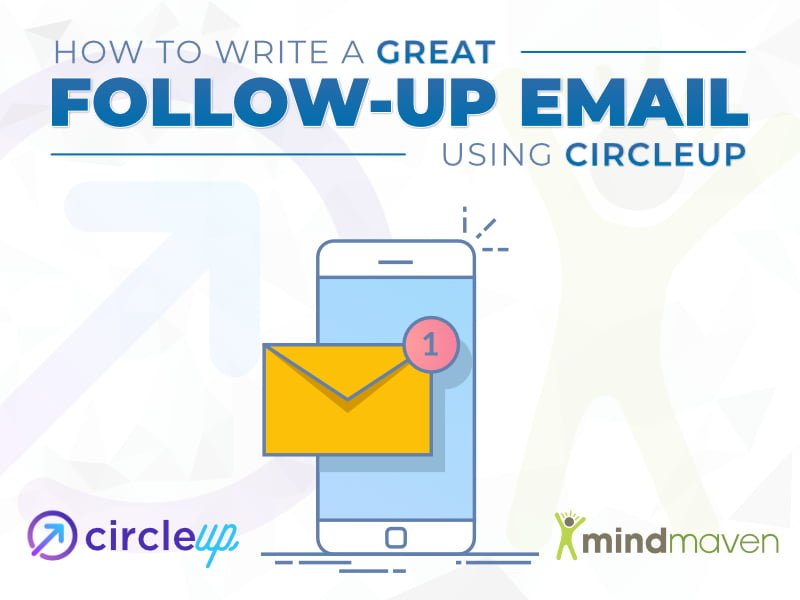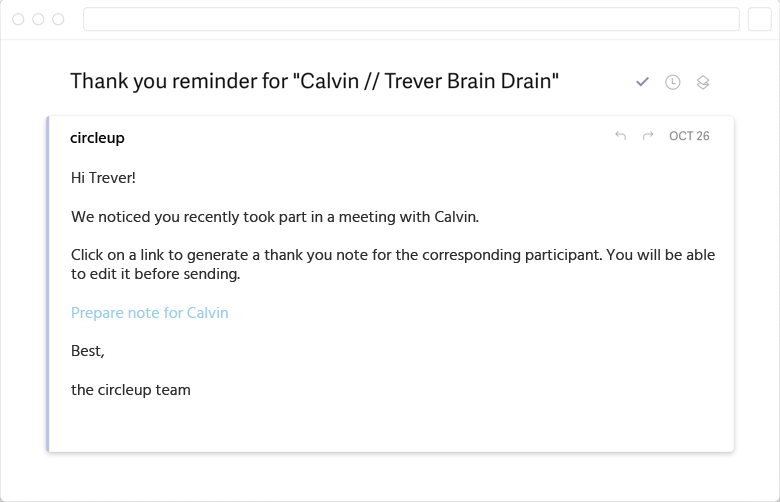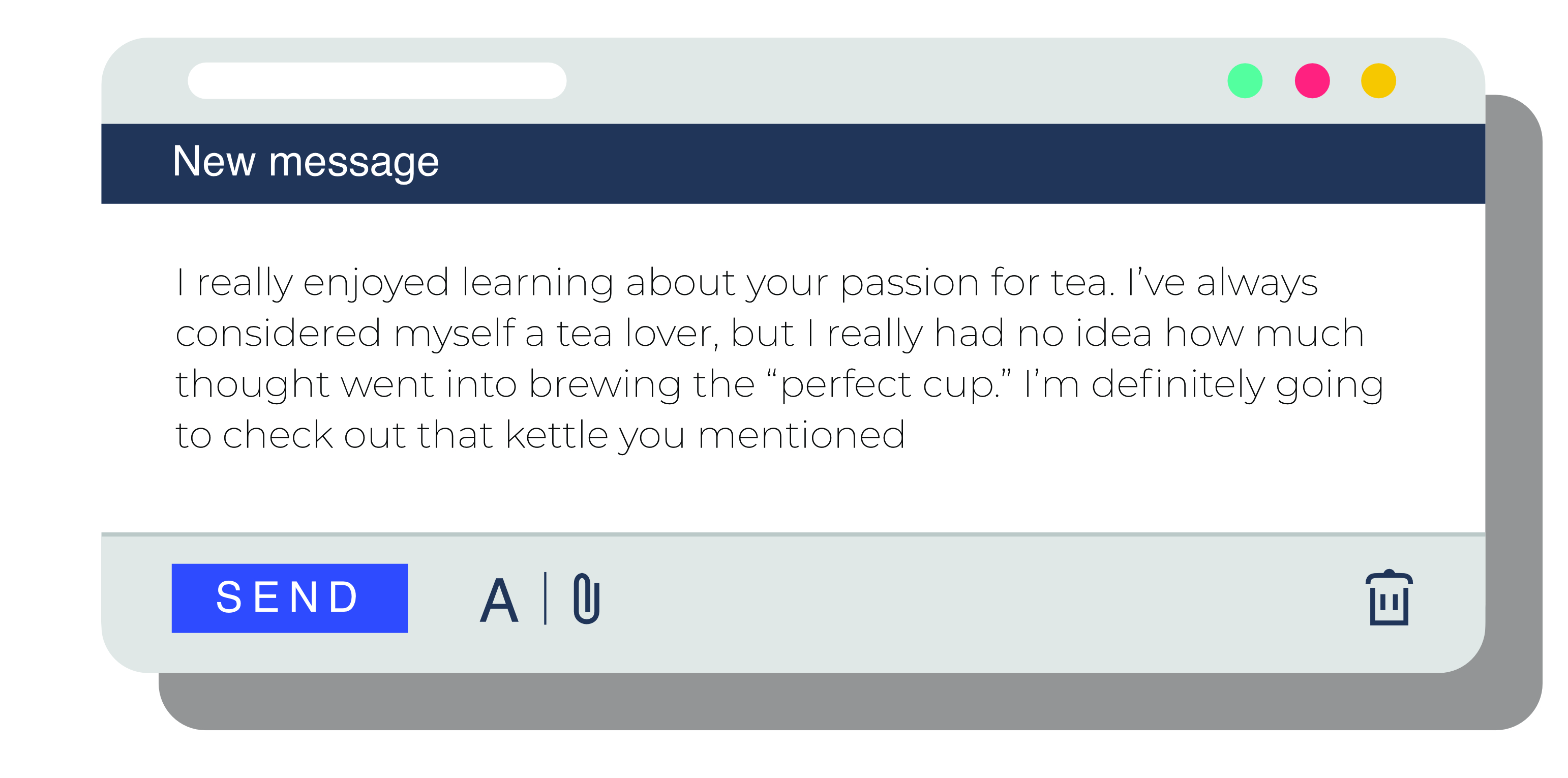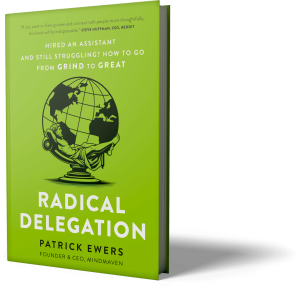If you spend 30+ minutes meeting with someone, would you agree it’s generally a good idea to send a follow-up email?
I’ve asked that question hundreds of times over my career, and the answer’s almost always a resounding “Yes!” But there’s a catch … Those same people who agree it’s important are also the first to admit that they actually do it less than half the time.
Why the disconnect?
Why do people who admit follow-up emails are important fail to send them more often than not? We’ll explore that in detail soon, but the short answer’s this: Consistently writing truly meaningful follow-up emails takes both time and effort; time and effort it often feels like we don’t have.
So what do we do about that?
There are a number of potential solutions out there, but I want to highlight one in particular: CircleUp. CircleUp is an innovative tool that automates the most time- and effort-intensive parts of the follow-up email process, reducing what’s often a 10-15 minute process to less than five. Here’s a quick video detailing how:
In this blog post, I’ll share how to combine CircleUp’s powerful automation tools with Mindmaven’s pragmatic, relationship-driven best practices to write follow-up emails that deliver great experiences to anyone in your network; all in just minutes a day.
The Power of Mindshare (and Why Follow-Up Emails Still Matter)
But before we get there, let me address a common question: Why bother? What difference is sending a follow-up email really going to make?
Put simply, all the difference. Let me explain.
Here at Mindmaven, we believe the best things in life come from our relationships, and that the only way to generate the game-changing opportunities you need to take things to the next level is to learn to better leverage your network.
But when it comes to relationships, you can only take out what you put in; and relationship management is often a game of inches. More often than not, the difference between winning and losing an opportunity is rarely decided by grand gestures.
In reality, the winner—the person who consistently generates breakthrough opportunities—is the person who took the small “extra steps.” Extra steps like sending a meaningful, relevant, valuable follow-up email after a meeting.
Here’s why: By sending a follow-up email, you increase your mindshare—or how “top-of-mind” you are—with that person. And the more mindshare you have with someone, the more likely they are to think of—and refer—you when they encounter the types of opportunities you want to hear about.
Make sense? Now let’s explore what stops most people from sending follow-up emails.
Why We Often Fail to Send Follow-Up Emails (and How to Use CircleUp to Solve the Problem)
This probably isn’t the first time you’ve thought about sending follow-up emails. It’s probably not even the first time you’ve tried to turn it into a habit.
And the first couple days probably went well! You found yourself sending emails after almost every meeting. But then, a few days or weeks in, something happened.
A crisis arose, priorities changed, and your habit-in-process was interrupted. All of your time, energy, and focus shifted to the crisis at hand, and you forgot about sending follow-up emails.
Of course, that crisis eventually ended. Things went back to normal. But the emails never started back up. Sound familiar? It’s the classic story of a well-intentioned habit being crushed before it’s fully-formed.
If you’re ready to commit to this habit once-and-for-all, and want to skip the painful (and often failure-prone) process of habit-building, CircleUp offers a powerful, automation-driven alternative. Here’s how.
#1: Follow-Up Email Reminders
First, CircleUp sends you real-time email prompts after each meeting on your calendar. These reminders, as simple as they may be, dramatically reduce the likelihood that you’ll forget to send a follow-up email. After all, they’re going to live in your inbox until you act on them.
Plus, given the fact that these reminders arrive in your inbox immediately after the meeting rather than at the end of the day, CircleUp empowers you to follow-up in-the-moment. This is powerful for two reasons:
- Immediately following a meeting, the interaction is still fresh in your mind and you’re able to write a more personalized, meaningful message.
- You’re able to build trust and establish a powerful reputation in your network as someone who not only always sends a follow-up, but who sends a follow-up within hours (if not minutes) rather than days (if at all).
#2: Follow-Up Email Templates
The second way CircleUp dramatically reduces the time and energy tax of follow-up emails is by including an easy-to-use, completely customizable follow-up email template.
But there’s a catch: Just “sending a follow-up email” isn’t enough.
There’s no reason to clog up someone’s inbox with an email that simply says, “Thanks for meeting today, I enjoyed our conversation.”
While short thank you emails are often better than none at all, we don’t want to add noise to your network’s inbox with emails that aren’t providing value of some kind. The secret to writing a great follow-up email—one that builds relationships and generates opportunities—is to make it meaningful, relevant, and valuable to the recipient.
And don’t worry: At the end of the article, I’ll share a ready-to-use email template you can load directly into CircleUp and start using today. But before we get there, it’s important you understand the three elements of a great follow-up email to really get the most out of that pre-prepared template.
The Three Elements of a Great Follow-Up Email
An effective follow-up email has three primary components: A statement of gratitude, a re-establishing of common ground, and a commitment to action items. Let’s take a closer look at each element.
#1: A Statement of Gratitude
This might seem obvious, since almost every follow-up email contains a “thank you” statement of some kind; but there’s two types of gratitude: Obligatory and genuine.
If all your email says is some variation of, “Thanks for meeting with me,” it’s obligatory gratitude. In other words, it’s expected; it’s a social nicety that makes no real positive impact on the relationship.
Focus instead on genuine gratitude by asking yourself: What did I specifically enjoy about this meeting or this person? And how could I thank them for it? Let me give you an example.
#2: A Re-Establishing of Common Ground
Common ground is the single most valuable aspect of building meaningful, valuable relationships.
Why? Because when someone finds common ground—or a shared interest or experience—with you, it causes their brain to think, “I am like you.” But because of the way our brains process language, that thought ultimately translates to, “I like you.”
Beyond that, re-establishing common ground also makes your emails feel more personalized and less templatized (something incredibly important since we are, in fact, using templates).
So go out of your way to find common ground throughout the meeting and, once you do, be sure to capture it in the follow-up email. Let’s take a look at an example.
#3: A Commitment to Action Items
The final component of a great follow-up email showcases your commitment to the relationship by capturing all the promises made by and to you over the course of the meeting.
By summarizing any action items, you emphasize the productivity of the meeting, instill confidence in the other person that you’re going to follow through, and increase the likelihood that they will deliver on their commitments as well.
Let me give you an example of how this might look.
Bringing it All Together: An Example of a Great Follow-Up Email
Alright, now let’s bring the three elements above into a single email to showcase how this might look.
Your Ready-to-Use Follow-Up Email Template
And there you have it.
Do you see how each of the three components work together to create an email your recipients are likely to perceive as meaningful, relevant, and valuable? Or, at the very least, much more impressive than the obligatory, “Thanks for meeting!” email most people send (if they send one at all)?
Of course, the increased value of this email comes at a pretty hefty cost: Writing an email like that from scratch each time simply isn’t scalable. It takes time and mental energy to incorporate each element. Thankfully, that’s where CircleUp can help.
They’ve already created a ready-to-use follow-up email template based on our best practices and, as a CircleUp user, all you have to do to access that template is click here: Activate Mindmaven’s Follow-Up Email Template in CircleUp.
Once you click that link, this will now be your default follow-up email template. A couple quick notes before you’re ready-to-go, though: Be sure to review the language of the follow-up email template and ensure it matches your style. If it doesn’t, feel free to make changes!
More specifically, consider updating …
- The greeting: How do you start emails? “Hi?” “Hello?” “Hey?”
- The tonality: Do you use exclamation points, or do you prefer periods? Do you like contractions like “here’s,” or do you prefer the two word “here is/are” approach?
- The closing: How do you typically close emails? “Thanks?” “Best?” “Cheers?”
Make whatever tweaks you feel are necessary to make it match your tone, but make sure the changes aren’t so dramatic that you lose one of the three vital elements.
Here’s a short 26-second video demonstrating how the process should work:
Once you’ve done that, you’ll be good-to-go! You’ll get email reminders from CircleUp after each meeting on your calendar. All you’ll need to do is click the link in the email, make a few personalization tweaks to the template based on the meeting, and press send!In no time, you’ll be delivering high-quality, opportunity-generating interactions to everyone you meet with; and the payoff this simple practice can have can’t be understated.Happy sending!
Copy-and-Paste Follow-Up Email Template & Quick-Reference:
Hi [Name],
Thanks so much for taking the time to connect today. I really appreciated your insights on [something you’re genuinely, specifically grateful for].
Also: I really enjoyed learning about [something you have in common, be it an interest, experience, or shared contact].
Anyway, here’s the next steps and key takeaways as I remember them from our conversation:
- [Include both commitments made by you to the other person, and by the other person to you].
If you feel I missed anything, please let me know. Otherwise, have a great rest of your day, and I look forward to [immediate next step]!
Cheers,
[Name]








